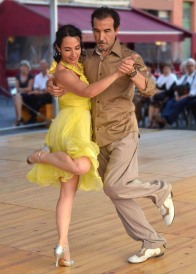Whether you were a good dancer back in the day or not, you should consider taking Dance Classes if you are looking for a fun physical activity that has great benefits to your health. Dancing as a form of exercise isn’t just for weight management but benefits your health in other ways like improved cardio and respiratory function, strengthened muscles, stronger bones, better coordination and flexibility as well as improved balance and spatial awareness, that help reduce the risk for falls and injuries. Psychologically, dancing can build your self-confidence, boost your self-esteem and reduce the levels of stress, anxiety and depression.
1. Ballroom
The most common dance class among older adults is Ballroom Dancing. Learning how to foxtrot, swing, waltz, rumba or tango is a great exercise for balance and agility. Not only that, you also get to dance to old school classics. Encourage your partner to take classes with you and make it even more fun and enjoyable.
2. Zumba
If you haven’t heard about Zumba then where have you been? This dance craze is a very popular cardio workout that is Latin-inspired. The workout incorporates different low to high intensity dance/fitness routines set to Latin rhythms. There are different types of Zumba classes – classic, fast-paced, low-impact and even water-based. You just have to choose what suits your fitness level best. What’s great about Zumba is that you can just do it in the privacy of your own home. There are tons of Zumba DVD’s that you can buy, as well as Zumba Dance Videos that you can stream online.
3. Jazzercise
This has been around since 1969 but today, you can find Jazzercise classes that incorporate elements of yoga and kickboxing with the classic dance routine. It’s a great low-impact full-body workout.
4. Barre
If you don’t want jumping or bouncing, try Barre classes. A Barre Workout involves ballet-based routines taught by legit Ballet dancers. The exercise focuses on movements to tone muscles and build flexibility. It’s a great exercise to improve posture, balance and isometric strength training which are all helpful to avoid fall injuries.










